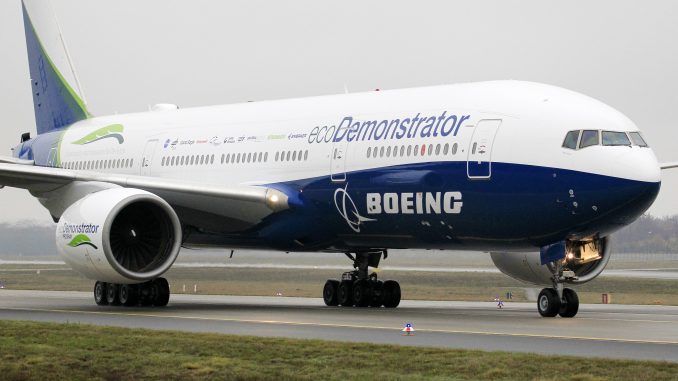
Last month, Boeing’s 2019 ‘ecoDemonstrator’ aircraft, a 777-200, visited Frankfurt Airport in Germany, making it its first tour outside the United States.
Under the so called ecoDemonstrator program, Boeing is working with a number of partners into researching and developing new technologies to make flying more efficient, safe and comfortable. The program already saw a series of aircraft being outfitted with experimental testing equipment over the past few years.
It was initially launched in 2010, with the first aircraft being introduced in 2012, in a cooperation with American Airlines, which provided a 737-800 in its livery for the project. In 2014, Boeing used one of its own 787 Dreamliners as a test bed aircraft. It was followed by a 757 in a partnership with TUI Group in 2015, an Embraer E170 regional jet in 2016, and a FedEx 777 freighter in 2018, until Boeing unveiled the aircraft for 2019 this summer: a 777 in Boeing’s own livery.
Boeing is showcasing its latest #ecoDemonstrator airplane, a 777-200, at Frankfurt Airport. Today, it was opened to local students, people working with the multi-national project, and journalists. pic.twitter.com/sc4a4up4ec
— International Flight Network (@FlightIntl) November 19, 2019
The plane
As mentioned above, this year’s ecoDemonstrator is a Boeing 777-200. The aircraft was originally built in 2001 and flew for Chinese flag-carrier Air China until last year. Its livery is similar to the Boeing house color scheme that you can see on the manufacturer’s newer aircraft types, including the 787 Dreamliner, 777X and 737 MAX. It looks a little more basic, and has the program’s symbol (a green leaf) painted on the tail.
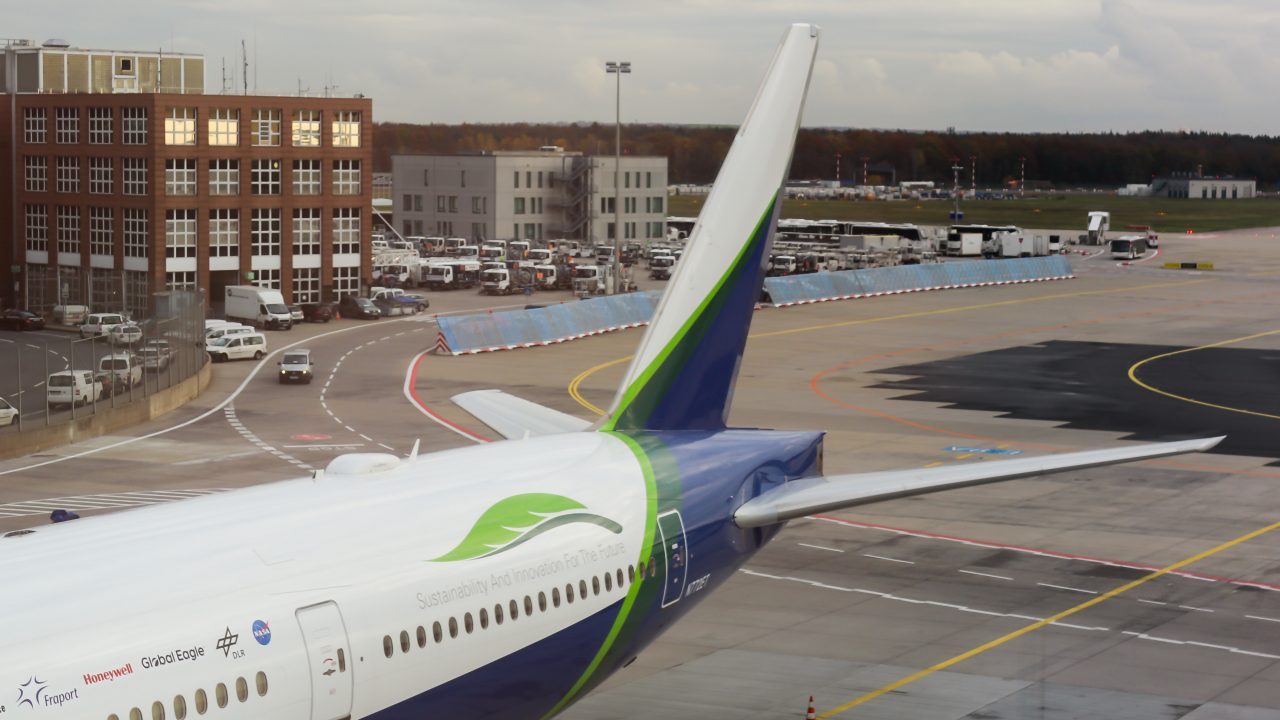
Boeing says it – and over a dozen partners – are testing 50 different technologies on the 2019 airplane. However, other than the name ‘ecoDemonstrator’ suggests, these include all kinds of technologies, many of which have nothing to do with the ‘eco’ part in the project’s name at all.
That is not to say the aircraft isn’t experimenting in the areas fuel use and carbon emissions. During a briefing, Boeing only mentioned one thing that is directly decreasing emissions on the airplane itself through aerodynamic improvements: ‘smart’ vortex generators. However, there are other technologies as well, such as optimized routing, which is increasing the overall efficiency by avoiding unnecessarily long flight paths. We’ll take a closer look at these solutions later on.
Cabin
The easiest thing to show in an aircraft that is parked at a terminal gate, is the cabin. Boeing’s media tour was therefore heavily based on cabin improvements. The US-American manufacturer got quite a lot of suppliers on board for this part of the plane, with a surprisingly strong presence of German companies (maybe that is why Boeing is showing us the aircraft in Frankfurt?), and calls this 2018-launched partnership ‘Intelligent Cabin Collaboration Team’. Almost every new feature inside this plane is in some way called ‘intelligent’, ‘smart’ or ‘connected’.
Most of the cabin innovations are based on connectivity, some features are even comparable to smart home devices for example. Diehl Aviation has developed a ‘smart galley’. “[The] Galley features inventory and electrical power management, chiller integration and efficiency, health management and communication with the airplane cabin network“. It collects usage and performance data – just like a smart home. A nice effect of this is that things can, apparently, predict when they break. Additionally, the trolleys are now getting automatically secured once they are pushed into the galleys.
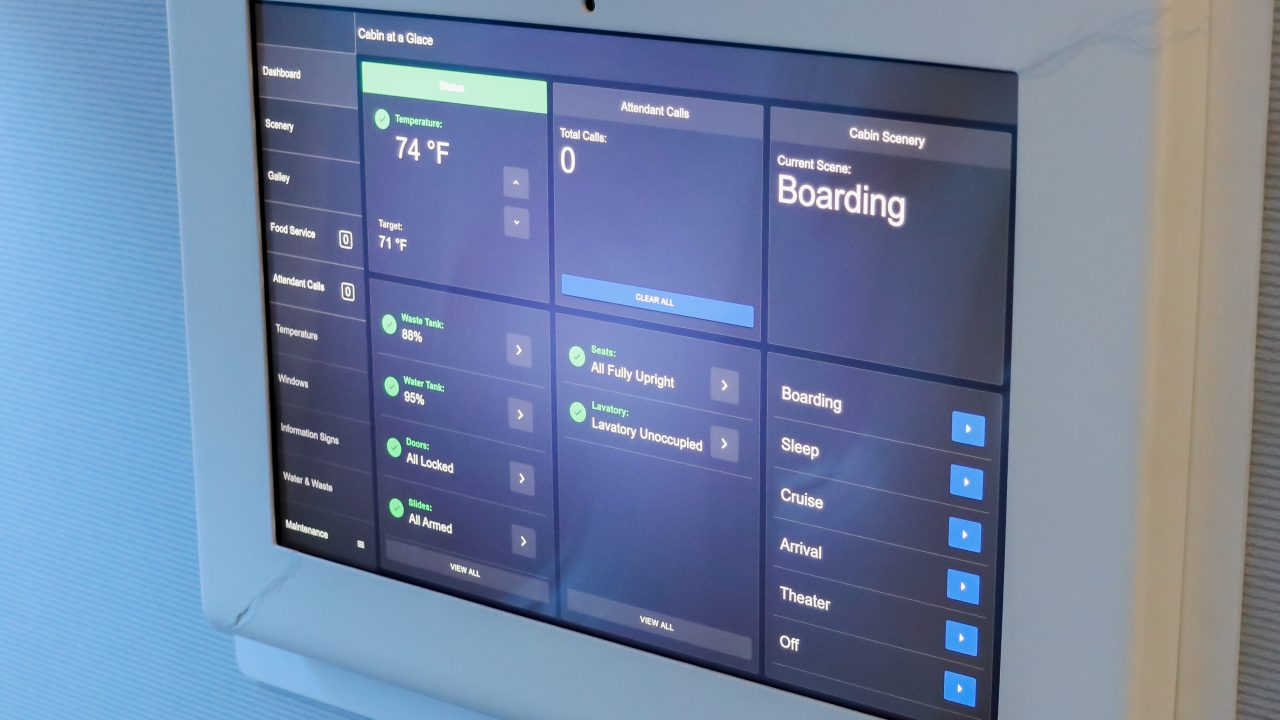
Another addition to the ‘smart cabin’ is a self-adjusting Business Class seat by Adient Aerospace, which features wireless communication with the cabin. This means that the seat can automatically be adjusted by the cabin crew for take off and landing, therefore reducing workload and avoiding conflict points with passengers.
Heading to the more ‘visible’ cabin demonstration area, the first thing you notice is, there are big screens. And not just any screens, but OLED screens (you might know them from your latest-generation smartphone). It looks like Boeing thought it was a great idea to remove a whole chunk of hand luggage storage in the middle-section and instead built in a huge screen on the ceiling. It was not immediately clear what the use, let alone need for this particular feature was, other than looking somewhat impressive at first glance. But we have to be fair to the ‘Intelligent Cabin Collaboration Team’: This is a test aircraft and testing never hurts. The guides even said that right now, this is not something airlines are going to build into their aircraft. However, as screen technology evolves and becomes more flexible, we might one day see screens in spots were they don’t take away space for about two dozen bags.
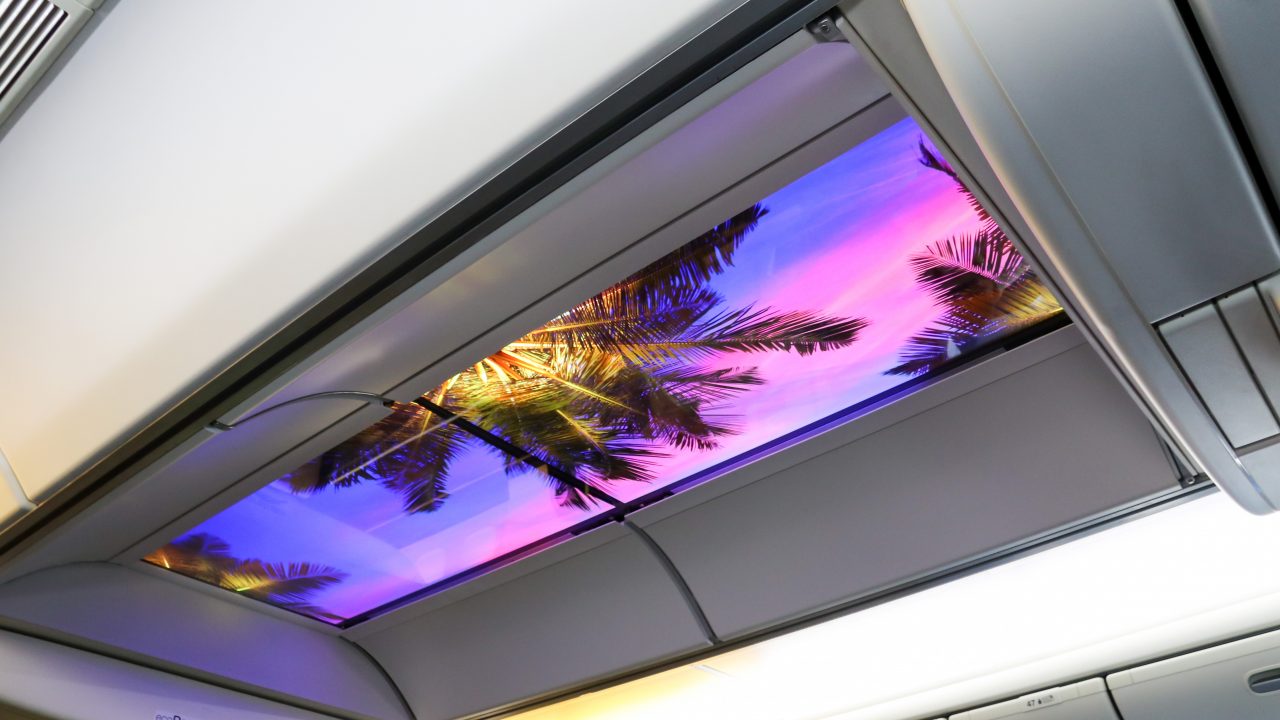
The passenger cabin part of the aircraft also features one big screen at the front, along with LED lights and sound systems. Cool lighting and sound effects is something we can’t avoid in new aircraft anyway nowadays, but at least they make for a good party mode – which is what Boeing actually showed us.
Additional screens can certainly be useful for displaying valuable information to passengers and crew. However, the way they are implemented in this flying test bed is rather inefficient, annoying for the passengers (you don’t want to stare at screens all the time), and probably expensive too.
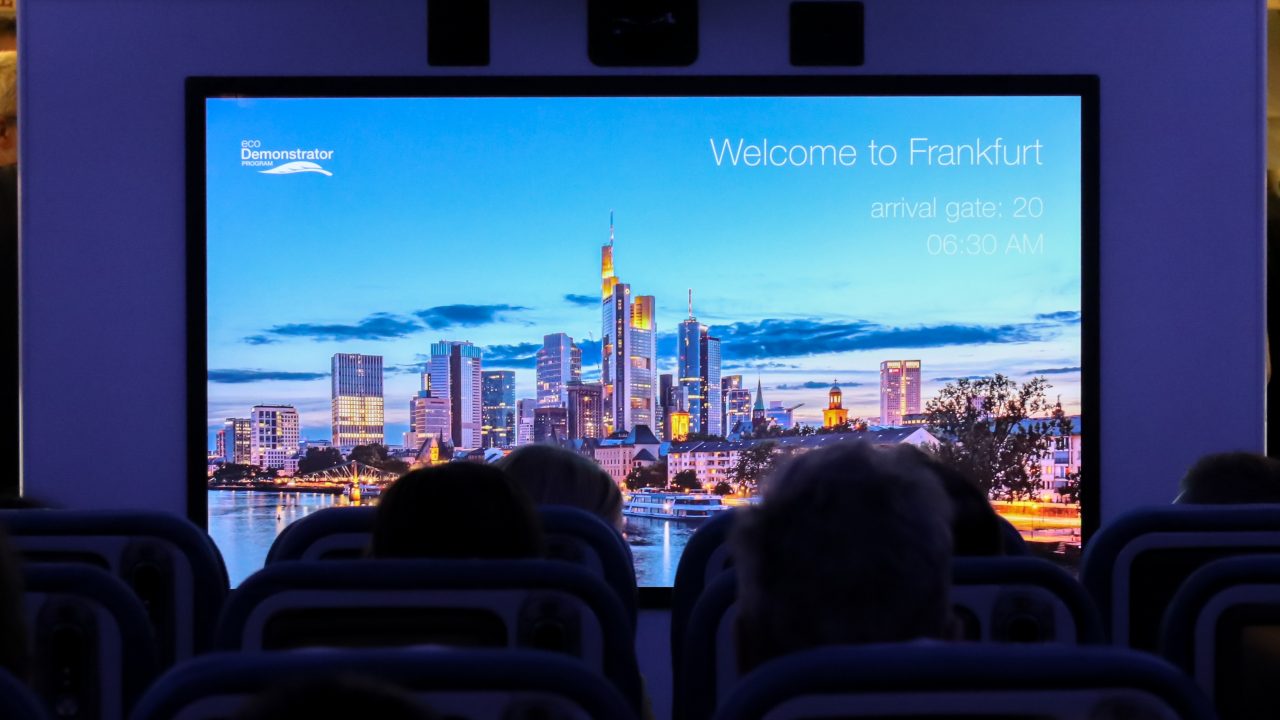
On the more practical side of the cabin, the teams showed us a ‘smart’ lavatory, they call it ‘Clean Cabin Fresh Lavatory’. This name stands for a lavatory that cleans itself, by using UV-sanitation, which ‘eliminates microorganisms’ (bacteria) and avoids the need to use chemical products to clean the surface areas. The ‘self-drying’ floor is made from recycled carbon fiber. Not only does this improve the cleanliness, but it also reduces manual efforts needed to clean the lavatory.
Given the rather deterrent image of current airplane toilets, this sounds like a good feature to implement in future cabins.
Additionally, the aircraft is equipped with a new water disinfection system. It gets rid of mercury lamps and instead uses UV-waves. Boeing says this system eliminates hazardous materials and reduces maintenance efforts.
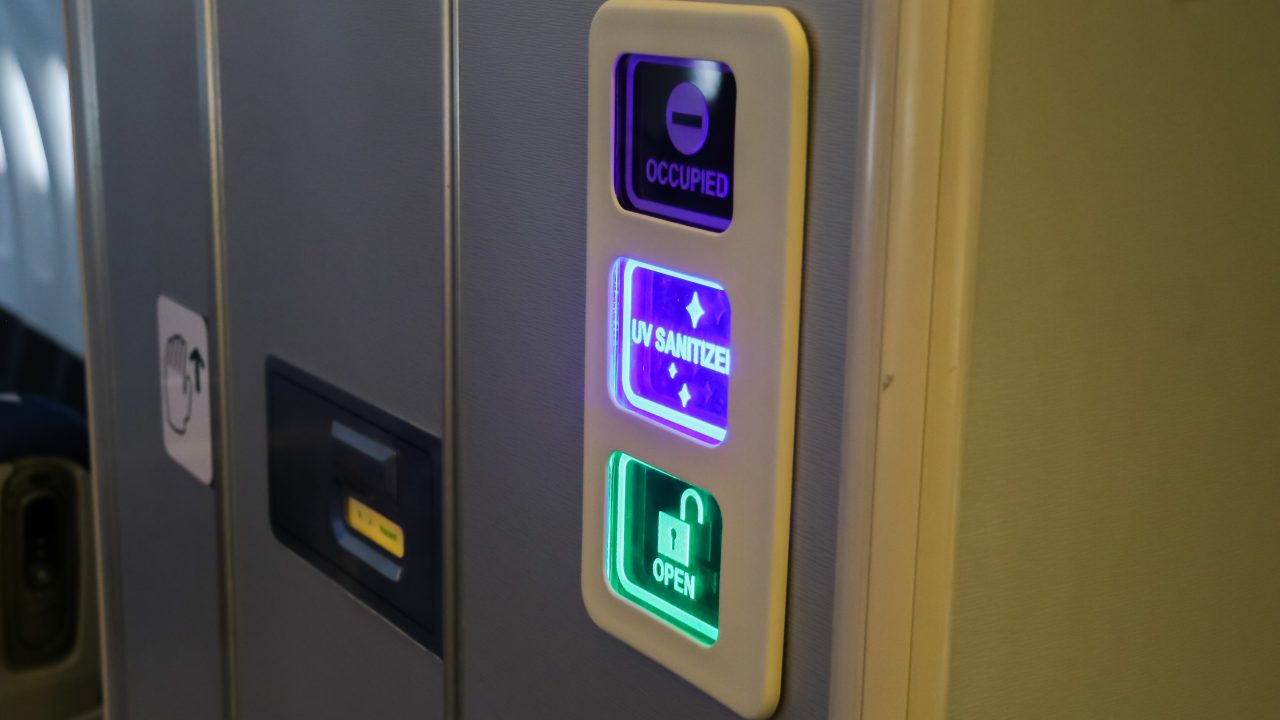
Aerodynamic experiments
One thing we found particularly interesting are the ecoDemonstrator’s ‘smart’ vortex generators, which are mounted on the right wing of this 777. These little aerodynamic additions to the aircraft’s wing, developed by Boeing and NASA, are about half the size of a human hand. The fascinating part about them: They change their shape based on the outside temperature. This causes them to retract at cruise altitude to reduce drag and extend at lower altitudes to ‘improve aerodynamic efficiency’ during takeoff and landing.
An issue with regular vortex generators is, that while they benefit the flight at lower speeds (takeoff and landing), they end up increasing drag at higher altitude and speed, making many potential applications in aviation inefficient.
The technology is only experimental and we are yet to see this being implemented on a larger scale. In the case of this ecoDemonstrator, there are only three of these thermally active vortex generators attached to the obviously huge ‘Tripleseven’.
Boeing says once fully developed, this feature will help reduce fuel use and emissions. The actual gains are ‘incremental’, but as with everything in this industry, it adds up over time – and even minor increases in efficiency are important steps.
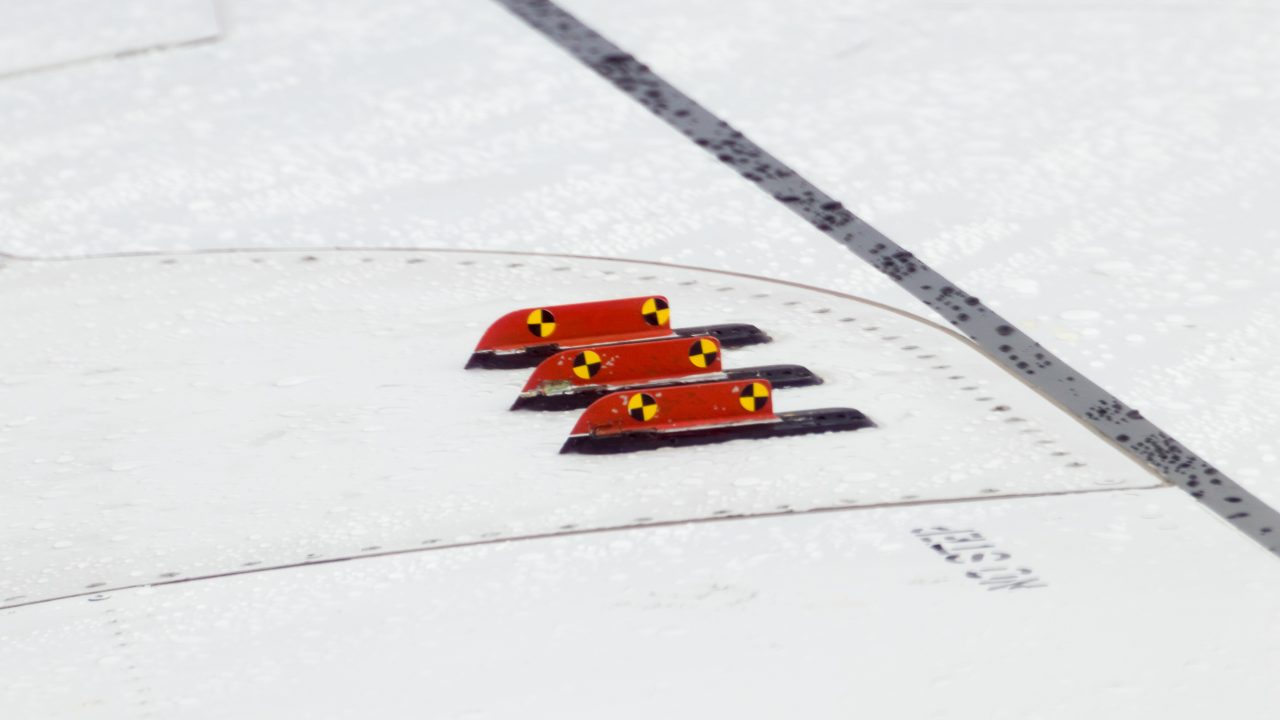
A different approach to improve the overall flight, which might become useful for both pilots and passengers, is being tested further at the front of the aircraft. One window has been modified to fit the so-called ‘Air Data Measurement System’. From the outside, this looks like someone put an orange plate behind the window. Inside, you can see the tech and cables that are build into this orange plane.
Optical sensors are being used to collect ‘more reliable and robust information for pilots’, using lower-weight equipment, compared to traditional systems. Boeing says these sensors can better detect turbulence, and therefore contributes to a more comfortable and safe flight. The aircraft’s cockpit also features more options for the pilot’s head-up-display (HUD).
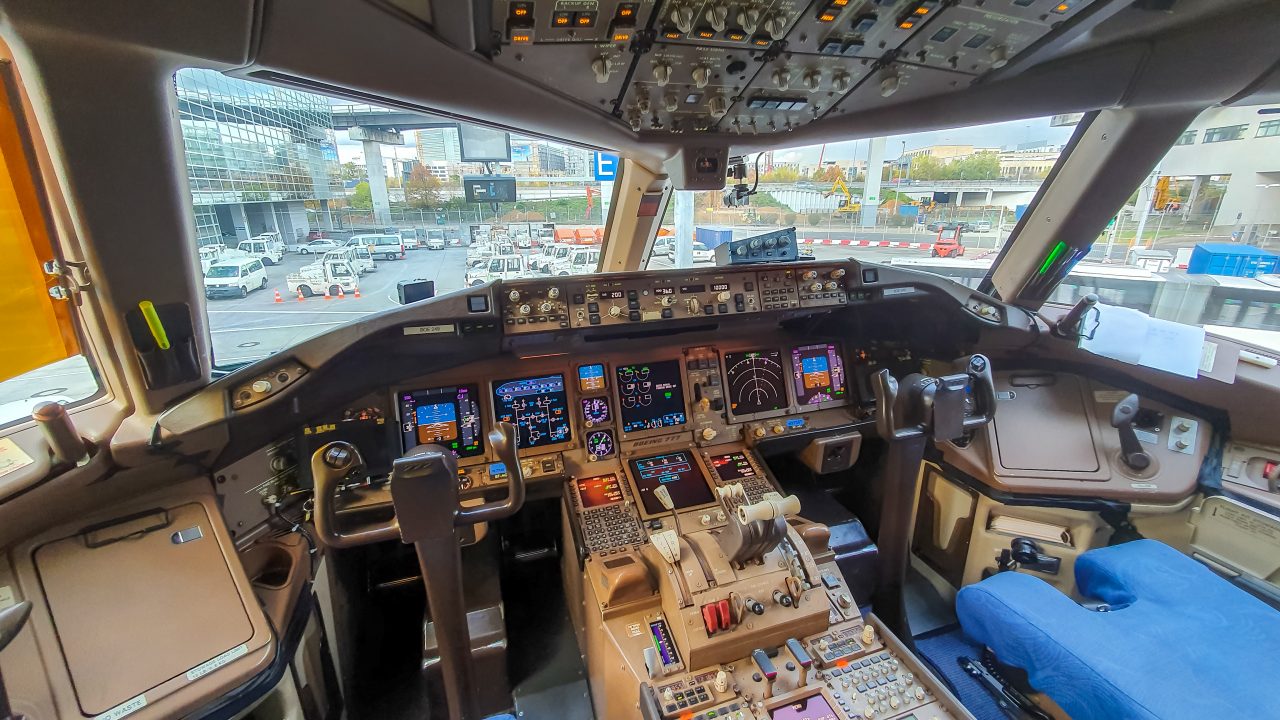
Structural parts
The further we go down the list of things built into this ecoDemonstrator, the more difficult it becomes to show – because many advancements are not directly visible inside nor outside the aircraft. This is were we get to the structure and building parts of the aircraft. While most of the metal can be recycled at the end of an airplane’s life, many of the materials critical for durability are hazardous.
More specifically: currently being used is a chromated primer to protect aluminum structures from corrosion, the substance therefore plays an important role in aircraft durability. The manufacturer wants to get rid of the hazardous chromates, it therefore tests a total of 18 potential alternatives to evaluate the durability of these materials.
One step that is expected, but has a surprisingly positive impact on the overall production, are aluminium parts made using 3D-printing. This method reduces material waste and production efforts, while also offering more flexibility and enabling the creation of more sophisticated designs.
Since this aircraft is old and not new-built, it is of course difficult to implement 3D-printing in crucial parts of the triple-seven. But Boeing did show us a 3D-printed ‘nose landing gear steering cable compensator bracket’. It probably requires the development of a completely new aircraft type to be able to actually build in a lot of 3D-printed tech – unfortunately this won’t happen very soon, looking at the decreasing chances of a potential 797 in the coming years. Using this second-hand 777-200 is significantly cheaper, but not more efficient. Apart from that argument, and ‘flexibility’, Boeing didn’t really seem to have an argument for the use of this particular type. To be fair, most technologies can be tested on a 777 the same way as on, let’s say, a 787 Dreamliner.
Traffic management
Around ten percent of fuel and emissions could be saved, if aircraft flew more efficient routes from airport to airport. The current reality is, while flight paths are calculated prior to the flight, actual changes during the flight are often not possible without further effort, as everything in the skies needs to be controlled via radio-based Air Traffic Control (ATC), which is divided in different geographical sectors. In most cases, pilots must stick to the plan that was created prior to the flight. Aircraft usually do not communicate directly with one another regarding improvement of flight paths and collision avoidance.
Boeing wants to implement an automatic weather rerouting to save manual communication efforts. This would see the aircraft transmit its accurate position data via ADS-B (Automatic Dependent Surveillance – Broadcast) to ground-based systems. The data is then shared with ATC and Airline Operation Centers (AOC), that can make live-time changes to the flight path and send them back to the aircraft via satellite communication. Pilots will receive adjusted flight routes on their Electronic Flight Bag (EFB), an electronic information management device. The aircraft manufacturer also proposes to replace ground radar through ADS-B for coordination taking place on the ground (airport).
Similar research projects for solutions that could finally replace decades old ATC technologies are being carried out by several parties. For example, in the European Union there is a joint project called ‘SESAR’, as part of the Single European Sky (SES) Initiative, that coordinates research and development for improvements of Air Traffic Management (ATM) within Europe.
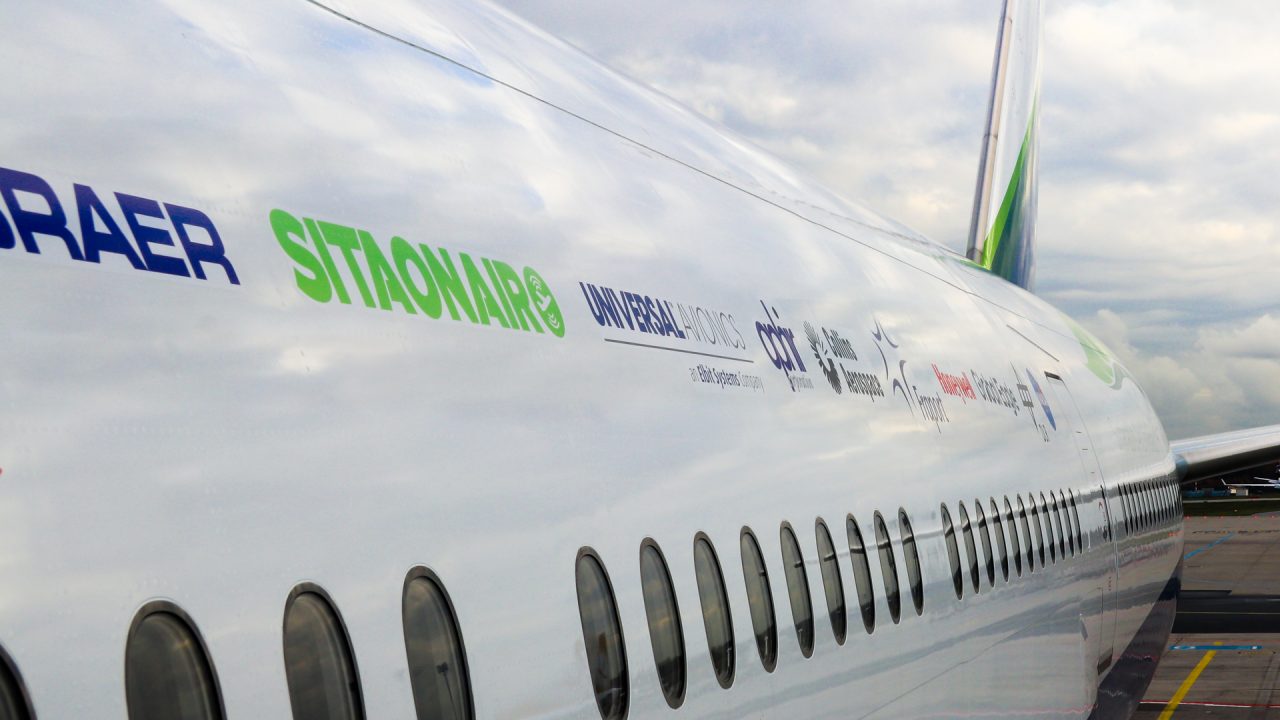
What is the future aircraft going to look like?
Sadly, only about 30 percent of all technologies from the ‘ecoDemonstrator’ program can be implemented in actual aircraft in the near future, according to Boeing. As with the 3D-printed parts, many improvements, especially those concerning the structural integrity of the plane are hard to actually use, unless you build a new type from scratch. Other things from this ecoDemonstrator will just end up being discontinued at some point, because they do not fulfill their expected goals, or prove themselves to be more or less useless.
Of all these experimental technologies shown on the plane, we are probably most likely to see cabin improvements in the nearer future. These developments, such as better lavatories, connected galleys/seats, more LED lighting (which is already a thing in modern airplane cabins) and so on, are way easier to build into an aircraft, compared to structural or aerodynamic changes, and could in many cases even be retrofitted to existing aircraft.
Does this justify the name ‘eco’? Not completely, at least not the cabin, no matter how ‘advanced’ Boeing calls it. The plane’s branding awakens the image of a project which is heavily focused on the reduction of emissions and fuel use, and therefore being eco-friendly. This is something the ecoDemonstrator program only partly fulfills. But at least it has got carpets made from recycled material, right?
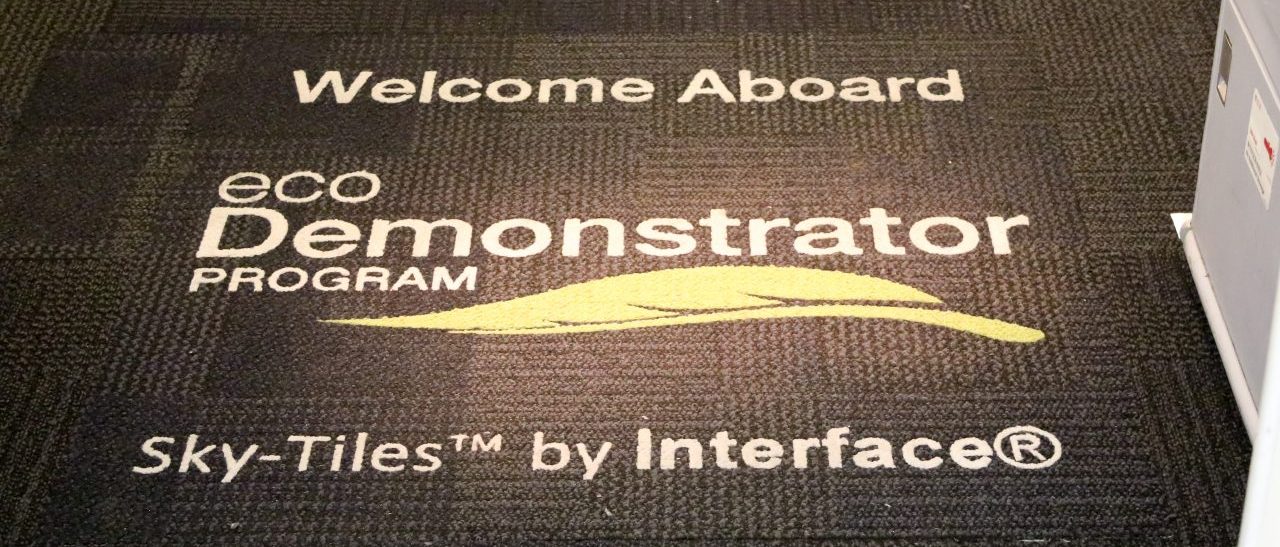
Making an aircraft more efficient (and therefore eco-friendlier) is not an easy task, and can for sure not be done on an 18 year-old 777, a type that was developed in the early 90s. Boeing could have used a newer aircraft. Although this might not make a difference for the testing equipment, it would have at least underlined the ‘eco’ branding.
However, in order to make progress, and be able to develop new aircraft using new technologies, manufacturers most importantly need to look at an existing platform to figure out how to improve it. The 777-200 therefore serves its purpose, even though it certainly isn’t the most efficient nor modern aircraft in the skies.

Jakob Wert is an aviation journalist from Germany. He built up the website IFN.news and is the Editor-In-Chief of International Flight Network.



